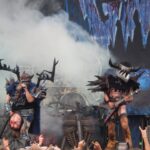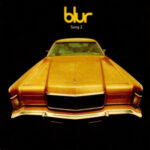 GWAR, a band as much about spectacle as music, has carved a unique niche in the world of heavy metal with their outrageous stage performances, elaborate costumes, and satirical, over-the-top personas. Emerging from Richmond, Virginia in the 1980s, GWAR’s blend of thrash metal, punk, and performance art has made them a cult favorite. Their story is one of creativity, controversy, and resilience, spanning over three decades.
GWAR, a band as much about spectacle as music, has carved a unique niche in the world of heavy metal with their outrageous stage performances, elaborate costumes, and satirical, over-the-top personas. Emerging from Richmond, Virginia in the 1980s, GWAR’s blend of thrash metal, punk, and performance art has made them a cult favorite. Their story is one of creativity, controversy, and resilience, spanning over three decades.
Formation and Early Years (1984-1988)
GWAR’s origins can be traced back to the Richmond Dairy, a dilapidated milk bottling plant turned artists’ collective. This space was a hub for creative minds, including Dave Brockie, who would become GWAR’s frontman under the alias Oderus Urungus. Brockie was originally part of a punk band called Death Piggy, and GWAR began as a side project with a focus on theatrics and shock value.
The initial idea was to create a barbaric band of intergalactic warriors, a concept that allowed for creative freedom and satire. The original lineup included Brockie, Hunter Jackson (Techno Destructo), and Chuck Varga (The Sexecutioner), who contributed to the visual and narrative elements of GWAR’s mythology. The early years saw the band experimenting with homemade costumes, props, and a storyline that framed them as ancient aliens banished to Earth to spread chaos.
GWAR’s early performances were chaotic and raw, marked by the band’s crude costumes and the liberal use of fake blood and other fluids. These shows quickly gained notoriety, drawing both fascination and outrage. By 1988, GWAR had developed a dedicated following and began to attract the attention of the broader metal community.
Rise to Notoriety (1988-1994)
The release of GWAR’s debut album, Hell-O (1988), marked the beginning of their rise to fame. While the album’s production was rough, it captured the band’s raw energy and irreverent humor. Tracks like “AEIOU” and “Gwar Theme” introduced audiences to their unique blend of thrash metal, punk, and satire.
GWAR’s breakthrough came with their second album, Scumdogs of the Universe (1990). This album featured more polished production and tighter musicianship, with standout tracks like “Sick of You” and “Maggots.” The band also expanded their live show, incorporating more elaborate costumes and stage effects. These performances became infamous for their graphic violence, sexual content, and satirical take on politics and pop culture.
The early 1990s saw GWAR becoming a cultural phenomenon. They made appearances on mainstream television shows like The Jerry Springer Show and Beavis and Butt-Head, which introduced them to a wider audience. The band’s antics also drew legal challenges and censorship attempts, further solidifying their reputation as provocateurs.
Despite (or perhaps because of) the controversy, GWAR continued to gain popularity. Their third album, America Must Be Destroyed (1992), was accompanied by a feature-length film, Phallus in Wonderland, which was nominated for a Grammy Award for Best Long Form Music Video. This period also saw the introduction of new characters, such as Slymenstra Hymen and Balsac the Jaws of Death, each adding to the band’s mythology.
Evolution and Challenges (1994-2000)
The mid-1990s were a period of evolution and experimentation for GWAR. Albums like This Toilet Earth (1994) and Ragnarök (1995) saw the band incorporating elements of funk, punk, and even disco into their sound. These releases continued to push the boundaries of taste and decency, with tracks like “Saddam a Go-Go” and “Meat Sandwich” offering sharp social and political commentary.
GWAR’s live shows became even more elaborate, featuring increasingly complex narratives and special effects. The band’s use of latex, foam, and animatronics set a new standard for concert theatrics. However, this period also brought challenges. Internal conflicts and lineup changes tested the band’s stability, and the financial strain of maintaining such a high level of production took its toll.
Despite these challenges, GWAR remained a prolific and influential force in the metal scene. Their relentless touring schedule and dedication to their craft earned them a loyal fan base. The late 1990s saw the release of albums like Carnival of Chaos (1997) and We Kill Everything (1999), which, while not as commercially successful as earlier efforts, demonstrated the band’s willingness to evolve and experiment.
Tragedy and Resilience (2000-2014)
The new millennium brought both tragedy and triumph for GWAR. In 2001, the band released Violence Has Arrived, a return to their thrash metal roots that was well-received by fans and critics alike. This album marked a period of renewed creative energy, with the band embracing a darker, more aggressive sound.
However, GWAR faced significant losses during this time. In 2005, guitarist Cory Smoot (Flattus Maximus) joined the band, bringing a new level of technical proficiency. Smoot’s contributions were pivotal in shaping the sound of albums like War Party (2004) and Beyond Hell (2006). Tragically, Smoot passed away in 2011 while on tour, a devastating blow to the band and their fans.
Despite the loss, GWAR pressed on, embodying the resilience that had defined their career. The band released Battle Maximus in 2013, an album that served as a tribute to Smoot’s legacy. This period also saw GWAR continuing to expand their mythology and stage shows, incorporating new characters and storylines.
In 2014, tragedy struck again with the death of Dave Brockie, the band’s charismatic frontman and creative visionary. Brockie’s passing was a monumental loss, not just for GWAR but for the entire metal community. His larger-than-life persona as Oderus Urungus had been the heart and soul of the band, and his death left a void that many feared could not be filled.
A New Era (2014-Present)
Following Brockie’s death, GWAR faced an uncertain future. However, the band’s ethos of resilience and reinvention came to the fore once again. They decided to continue, both to honor Brockie’s legacy and to keep the spirit of GWAR alive. Vocalist Michael Bishop, who had played bass as Beefcake the Mighty, stepped into the role of frontman as Blöthar the Berserker.
Under Bishop’s leadership, GWAR released The Blood of Gods (2017), an album that addressed Brockie’s passing and explored themes of mortality, legacy, and the band’s place in the world. Tracks like “Fuck This Place” and “El Presidente” demonstrated that GWAR had not lost their edge or sense of humor.
GWAR continued to tour extensively, bringing their spectacle to new generations of fans. Their live shows remained a hallmark of the band’s identity, combining music, performance art, and social commentary in a way that few bands could match. They also embraced new media, using social platforms and streaming services to reach a broader audience.
In 2020, GWAR celebrated their 35th anniversary with the release of Scumdogs XXX Live, a re-recording of their seminal album Scumdogs of the Universe performed live. This release was a testament to the band’s enduring appeal and their ability to adapt and thrive in an ever-changing musical landscape.
Impact and Legacy
GWAR’s impact on the world of music and popular culture is profound. Their commitment to theatricality and satire set them apart from their peers and created a unique niche in the metal genre. They have inspired countless bands with their DIY ethos, boundary-pushing performances, and willingness to tackle controversial subjects.
Beyond their musical contributions, GWAR has made significant cultural impacts. They have been featured in numerous films, television shows, and video games, and their influence can be seen in the work of artists across various mediums. The band’s combination of humor, horror, and social commentary has resonated with audiences around the world.
GWAR’s legacy is also marked by their resilience in the face of adversity. They have weathered lineup changes, financial challenges, and the loss of key members, yet they have continued to create and perform with unrelenting passion. This tenacity is a testament to their dedication to their craft and their fans.
Conclusion
GWAR’s history is a testament to the power of creativity, satire, and perseverance. From their humble beginnings in a Richmond artists’ collective to their status as metal legends, GWAR has consistently pushed the boundaries of what a band can be. Their blend of music, performance art, and social commentary has created a legacy that will endure for generations to come.
Through triumphs and tragedies, GWAR has remained a singular force in the world of heavy metal. Their story is one of innovation, controversy, and resilience, a testament to the enduring power of music and performance. As they continue to evolve and inspire, GWAR’s place in the pantheon of metal greats is secure, a legacy built on blood, sweat, and unbridled creativity.
This post has already been read 284 times!









